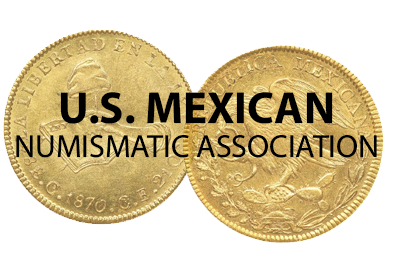Counterfeit Amecameca Copper 25 Centavos
by Scott Doll
Introduction
Mexico Revolutionary period coinage has been a challenge at times to collect as it is one of the most counterfeited areas in Mexican numismatics due to the crudeness and simplistic designs on many issues, and the apparent ease of counterfeiters to create a fake. This could make collecting this series frustrating, as well as exceedingly difficult since many collectors do not necessarily know the attributes of a legitimate coin compared to a post revolution fake or even a contemporary counterfeit.
The 25 centavos from the municipality of Amecameca has a plain edge, struck in copper, and has no date, but was struck in late 1915 or early 1916 under orders from revolutionary General Trinidad Sánchez Tenorio. Guthrie-Bothamley catalogued this variety as GB-252 and Carlos Amaya as A-EM-16.
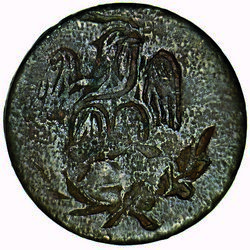
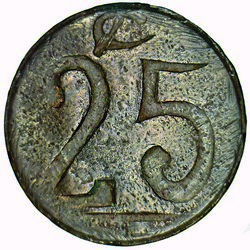
Genuine example
Plain Edge, 25.08 mm, 6.94 g.
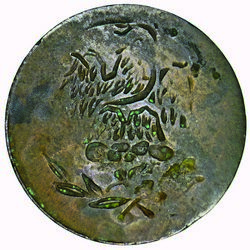
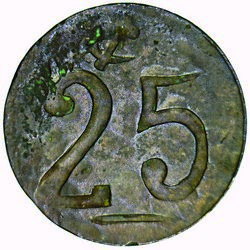
Counterfeit example
Plain Edge, 27.03 mm, 5.99 g.
Let me start by stating that I believe this counterfeit to be a modern fabrication and not something contemporary from the revolutionary period. Although it is entirely possible that it could be a contemporary strike, I strongly feel that it is a modern fake due to the following attribute’s evidence, as well as the fact that these have only been observed in the market since the early 1970s.
I would classify this counterfeit as dangerous since it is well made, and it can be difficult for someone to distinguish from a genuine coin unless you know the attributes of each. Upon a quick glance, the obverse and reverse on a genuine specimen is remarkably like the counterfeit specimen: however, upon closer inspection, it becomes apparent that there are subtle differences to include the centavos sign, the denomination digit design and finally the eagle’s legs and feather lines. Lastly, many genuine pieces have adjustment marks on the planchet while the fakes do not. The genuine pieces also have lathe marks within the “25” (denomination) while the fakes do not.
Let us begin by reviewing the edge or adjustment file marks on this sample genuine specimen, as well as the planchet lathe tool marks which are visible in the stamped area of the denomination on a genuine specimen.
Adjustment Marks
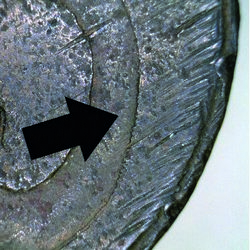
Many pieces show signs of file or adjustment marks which was done prior to the coin being struck. Most counterfeits do not have these marks.
Lathe Marks
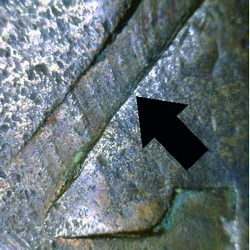
Within the “25” denomination, lathe marks can be easily seen at various areas within the numerals. Counterfeits do not have these marks as their surface looks smooth and flat.
Obverse Attributes Differences
Eagle Head & Feathers
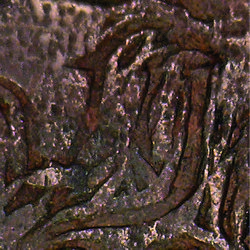
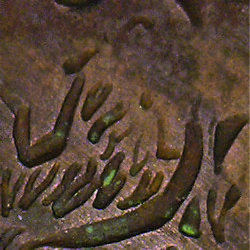
Genuine Counterfeit
The head on a genuine coin is distinct, while the head on the counterfeit is very weak around the area of the beak and top of the head. The feather lines on the genuine are also longer and fewer in number while the counterfeit is shorter and more numerous.
Eagle Legs
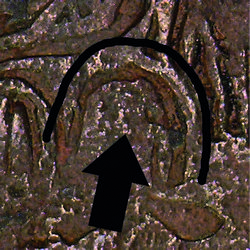
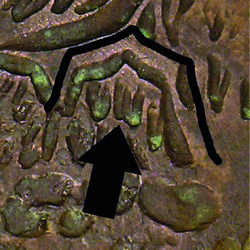
Genuine Counterfeit
The eagle’s legs are the easiest identifier to compare as the genuine strike is more rounded on the top line compared to the counterfeit which has a series of short, mostly straight interconnected lines. The feather lines within are also quite different as the genuine strike only has a couple of lines while the counterfeit has numerous short lines.
Stems & Leaves
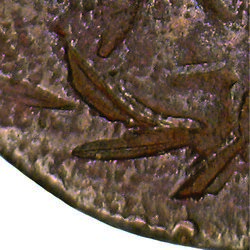
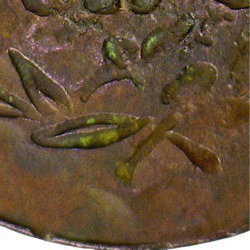
Genuine Counterfeit
The stems and leaves below the eagle on the genuine strike has thick, long stems while the counterfeit has thin, short stems. The leaves on the genuine are also thin, narrow, and not prominently outlined, while the counterfeit strike is wider and a little thicker in size, as well as noticeably outlined.
Reverse Attributes Differences
Centavos Sign
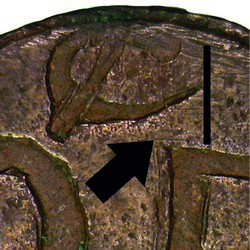
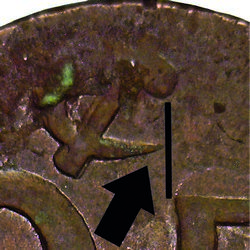
Genuine Counterfeit
The centavos sign is the easiest identifier to compare on the reverse. The genuine strike is positioned in the center area above the “25” denomination and has a long tail at the bottom that extends beyond the top bar of the “5” while the counterfeit is positioned more above the top of the “2” and has a short tail that does not extend beyond the top of the “5”
Top Ball of the “2” Denomination
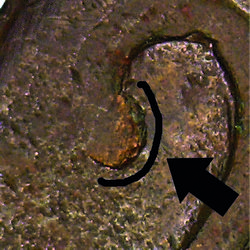
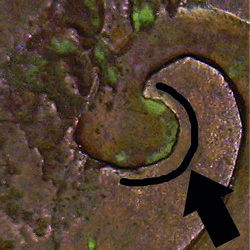
Genuine Counterfeit
TThe ball at the top of the “2” in the denomination on the genuine strike is much smaller in size and proportion, as well as more rounded in shape compared to the counterfeit which is larger and more oval shaped.
Bottom Ball of the “5” Denomination
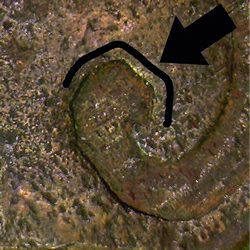
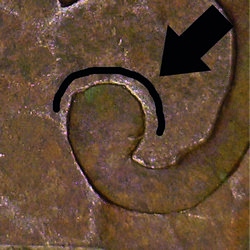
Genuine Counterfeit
The ball at the bottom of the “5” in the denomination on the genuine strike is irregular in shape (not fully rounded) and has a flat or straight area on the top right side, while the counterfeit is much more rounded and proportional in shape.
The genuine variety with an incuse design is known to be crude stamped in copper and reportedly in brass, although I have not yet seen a genuine brass specimen. I would consider the copper genuine strikes to be scarce, while the brass, if they do exist, to be quite rare. As for the counterfeits, these can also be found in copper as well as brass and appear to show up equally as a percentage within the market. Although the planchet metal may be different on the counterfeits, all other attributes mentioned within this article are the same to include the planchet size while the weight is slightly higher on the brass fake.

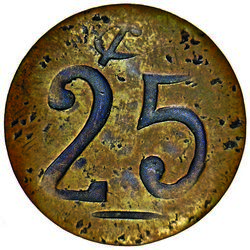
Modern Counterfeit
Plain Edge, 26.95 mm, 7.39 g.
Summary
The modern counterfeit Amecameca 25 centavos reviewed within this article is very well made, and as I mentioned earlier, should be considered a dangerous counterfeit: therefore, you should be wary when purchasing this variety unless you understand the key attributes differences since a genuine strike will be quite a bit more expensive and valuable than a counterfeit.
Please send your comments, questions, or suggestions regarding this article, to me at
